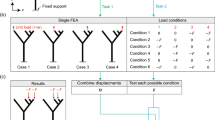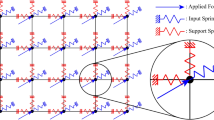Abstract
Current finite element analysis (FEA) and optimizations require boundary conditions, i.e., constrained nodes. These nodes represent structural supports. However, many realistic structures do not have such concrete supports. In a robust optimization, i.e., optimization for uncertain load inputs, it is desirable to involve support uncertainty. However, such a robust optimization has not been available since constrained nodes are required to convert the stiffness matrix to an invertible matrix. This paper demonstrates a quite simple robust optimization based on a pseudo-inverse stiffness matrix and eigenvalue analysis that successfully creates optimal design without constrained nodes. The optimization strategy is to minimize the largest eigenvalue of the pseudo-inverse matrix. It was found that optimization for multiple eigenvalues, i.e., multiple load inputs, is required as the nature of the minimax problem. The created structures are capable of carrying multiple load inputs—bending, torsion, and more complex loads. Configurations created in rectangular design domains exhibited hollow monocoque structures.

















Similar content being viewed by others
References
Ahmadi B, Jalalpour M, Asadpoure A, Tootkaboni M (2018) Robust topology optimization of skeletal structures with imperfect structural members. Struct Multidisc Optim 58:2533–2544
Andreassen E, Clausen A, Schevenels M, Lazarov B S, Sigmund O (2011) Efficient topology optimization in MATLAB using 88 lines of code. Struct Multidiscip Optim 43(1):1–16
Bendsøe MP (1989) Optimal shape design as a material distribution problem. Struct Multidiscip Optim 1:193–202
Bendsøe MP (1995) Optimization of structural topology shape and material. Springer, New York
Bendsøe MP, Sigmund O (2003) Topology optimization: theory, method and applications. Springer, New York
Ben-Tal A, Nemirovski A (2002) Robust optimization—methodology and applications. Math Program B92:453–480
Bruns T E, Tortorelli D A (2001) Topology optimization of non-linear elastic structures and compliant mechanisms. Comput Methods Appl Mech Engrg 190:3443–3459
Buhl T (2002) Simultaneous topology optimization of structure and supports. Struct Multidisc Optim 23:336–346
Chen S, Chen W, Lee S (2010) Level set based robust shape and topology optimization under random field uncertainties. Struct Multidisc Optim 41:507–524
Cherkaev A, Cherkaev E (1999) Optimal design for uncertain loading condition. Ser Adv Math Appl Sci 50:193–213
Cherkaev E, Cherkaev A (2003) Principal compliance and robust optimal design. J Elast 72:71–98
Cherkaev E, Cherkaev A (2008) Minimax optimization problem of structural design. Comput Struct 86:1426–1435
Courrieu P (2005) Fast computation of Moore-Penrose inverse matrices. Neural Inf Process - Lett Rev 8:25–29
Csébfalvi A (2018) Structural optimization under uncertainty in loading directions: Benchmark results. Adv Eng Softw 120:68–78
Dambrine M, Laurain A (2016) A first order approach for worst-case shape optimization of the compliance for a mixture in the low contrast regime. Struct Multidisc Optim (2016) 54:215–231
da Silva G A, Beck A T (2018) Reliability-based topology optimization of continuum structures subject to local stress constraints. Struct Multidisc Optim 57:2339–2355
De Gournay F, Allaire G, Jouve F (2008) Shape and topology optimization of the robust compliance via the level set method. ESAIM: Control Optim Calc Var 14:43–70
Díaz AR, Bendsøe MP (1992) Shape optimization of structures for multiple loading conditions using a homogenization method. Struct Optim 4:17–22
Fukada Y, Minagawa H, Nakazato C, Nagatani T (2018a) Structural deterioration of curved thin-walled structure and recovery by rib installation: verification with structural optimization algorithm. Thin-walled Struct 123:441–451
Fukada Y, Minagawa H, Nakazato C, Nagatani T (2018b) Response of shape optimization of thin-walled curved beam and rib formation from unstable structure growth in optimization. Struct Multidisc Optim 58:1769–1782
Groenwold A A, Etman L F P (2009) A simple heuristic for gray-scale suppression in optimality criterion-based topology optimization. Struct Multidiscip Optim 39(2):217–225
Guest J K, Igusa T (2008) Structural optimization under uncertain loads and nodal locations. Comput Methods Appl Mech Engrg 198:116–124
Guest J K, Prevost J H, Belytschko T (2004) Achieving minimum length scale in topology optimization using nodal design variables and projection functions. Int J Numer Methods Eng 61:238– 254
Guest J K, Asadpoure A, Ha S H (2011) Eliminating beta-continuation from Heaviside projection and density filter algorithms. Struct Multidiscip Optim 44:443–453
Ishii K, Aomura S (2004) Topology optimization for the extruded three dimensional structure with constant cross section. JSME Int J Ser A 47(2):198–206
Ishii K, Aomura S, Fujii D (2001) Development of topology optimization based on the frame based unit cell, (2nd Report, maximizing stiffness of the structure subjected to eigenvalues and volume). Trans Jpn Soc Mech Eng (Japan) 67A(664):1898–1905
James M (1978) The generalised inverse. Math Gazette 62:109–114. https://doi.org/10.2307/3617665
Kaveh A, Dadras A, Geran Malek N (2018) Robust design optimization of laminated plates under uncertain bounded buckling loads, Struct Multidisc Optim: https://doi.org/10.1007/s00158-018-2106-0
Kogiso N, Ahn N W, Nishiwaki S, Izui K, Yoshimura M (2008) Robust topology optimization for compliant mechanisms considering uncertainty of applied loads. J Adv Mech Des Syst Manuf 2:96–107
Leliévre N, Beaurepaire P, Mattrand C, Gayton N, Otsmane A (2016) On the consideration of uncertainty in design: optimization – reliability – robustness. Struct Multidisc Optim (2016) 54:1423–1437
Liu K, Tovar A (2014) An efficient 3D topology optimization code written in Matlab. Struct Multidisc Optim 50:1175–1196
Liu J, Wen G, Huang X (2017) To avoid unpractical optimal design without support. Struct Multidisc Optim 56:1589–1595
Ma Z D, Kikuchi N, Cheng H C (1995) Topological design for vibrating structures. Comput Methods Appl Mech Engrg 121:259–280
Mlejnek H (1992) Some aspects of the genesis of structures. Struct Optim 5(1–2):64–69
Moore E H (1920) On the reciprocal of the general algebraic matrix. Bullet Amer Math Soc 26(9):394–395. https://doi.org/10.1090/S0002-9904-1920-03322-7
Nakazawa Y, Kogiso N, Yamada T, Nishiwaki S (2016) Robust topology optimization of thin plate structure under concentrated load with uncertain load position. Journal of Advanced Mechanical Design, Systems, and Manufacturing 10(4):JAMDSM0057. https://doi.org/10.1299/jamdsm.2016jamdsm0057
MSC/NASTRAN Reference Manual (2005) .
Nocedal J, Wright S (2006) Numerical optimization, 2nd edn. Springer, Berlin
Penrose R (1955) A generalized inverse for matrices. Math Proc Camb Philos Soc 51(3):406–413. https://doi.org/10.1017/S0305004100030401
Holmberg E, Thore C J, Klarbring A (2017) Game Theory approach to robust topology optimization with uncertain loading. Struct Multidisc Optim 55:1383–1397
Rong J H, Yu L, Rong X P, Zhao Z J (2017) (2017) A novel displacement constrained optimization approach for black and white structural topology designs under multiple load cases. Struct Multidisc Optim 56:865–884
Rostami SAL Ghoddosian A (2018) Topology optimization of continuum structures under hybrid uncertainties. Struct Multidisc Optim 57:2399–2409
Shimoda M, Nagano T, Shintani K, Ito S (2015) Robust shape optimization method for a linear elastic structure with unknown loadings. Trans Jpn Soc Mech Eng 81:15–00353. (in Japanese)
Sigmund O (1997) On the design of compliant mechanisms using topology optimization. Mech Struct Mach 25(4):495–526
Sigmund O (2001) A 99 line topology optimization code written in matlab. Struct Multidiscip Optim 21:120–127
Sigmund O (2007) Morphology-based black and white filters for topology optimization. Struct Multidiscip Optim 33:401–424
Svanberg K (1987) The method of moving asymptotes-a new method for structural optimzation. Int J Numer Methods Eng 24:359–373
Takezawa A, Nii S, Kitamura M, Kogiso N (2011) Topology optimization for worst load conditions based on the eigenvalue analysis of an aggregated linear system. Comput Methods Appl Mech Eng 200:2268–2281
Thore C J (2016) Multiplicity Of the maximum eigenvalue in structural optimization problems. Struct Multidisc Optim 53:961–965
Wang M Y, Wang X, Guo D (2003) A level set method for structural topology optimization. Comput Methods Appl Mech Engrg 192:227–246
Yamada T, Izui K, Nishiwaki S, Takezawa A (2010) A topology optimization method based on the level set method incorporating a fictitious interface energy. Comput Methods Appl Mech Eng 199:2876–2891
Yamasaki S, Kawamoto A, Saito A, Kuroishi M, Fujita K (2017) Grayscale-free topology optimization for electromagnetic design problem of in-vehicle reactor. Struct Multidisc Optim 55:1079–1090
Zhang X, Kang Z, Zhang W (2016) Robust Topology optimization for dynamic compliance minimization under uncertain harmonic excitations with inhomogeneous eigenvalue analysis. Struct Multidisc Optim 54:1469–1484
Zhao J, Wang C (2014) Robust structural topology optimization under random field loading uncertainty. Struct Multidisc Optim 50:517–522
Zhou M, Rozvany G (1991) The COC algorithm, part II: topological, geometrical and generalized shape optimization. Comput Methods Appl Mech Engrg 89:30–336
Acknowledgements
The author would like to thank to K. Ishii, M. Tsukino, T. Hayashi, Y. Sato, C. Nakazato, and H. Minagawa in Quint Corporation, and M. Nakaoka, T. Nagatani, S. Yoshizawa, and A Kawamoto in Toyota Motor Corporation for their fruitful discussions. Special thanks to S. Nisiwaki, K. Izui, and T. Yamada in Kyoto University for their warm encouragement.
Author information
Authors and Affiliations
Corresponding author
Ethics declarations
Conflict of interest
The authors declare that they have no conflict of interest.
Additional information
Responsible Editor: Seonho Cho
Publisher’s note
Springer Nature remains neutral with regard to jurisdictional claims in published maps and institutional affiliations.
Appendix A: An example of a continuum elastic body
Appendix A: An example of a continuum elastic body
Consider a one-dimensional elastic body. The equilibrium equation and the formula of strain tensors in the body are as follows:
and
where f(x) is the force per volume.
In the same way as the finite element model, (29) and (30) can be reduced by Hook’s law as follows:
The solution of this equation is as follows:
where C1 and C2 are the constants of integration, and C1 corresponds to an effect of uniform background pressure which should be neglected. The constant C2 determines the displacement at certain position, and denotes a rigid body motion.
When the problem is support-free and the mean value of the input force is not zero, the natural boundary condition (zero stresses at the free ends of the body) cannot be satisfied.
The force input can be regarded as the sum of the balanced component fb and the unbalanced component fR, i.e., the mean value of f(x).
Substituting (33)–(31), the following relationship can be obtained.
This relationship seems equivalent with (8).
To cope with the difficulty of an unbalanced load, an additional weak constraint k is introduced as follows:
The exact solution of this equation is as follows:
and
C3 and C4 are constants. The natural boundary conditions determine the constants. At the limit of small k, the constants are as follows:
where L is the length of the body. Thus, the unbalanced component yields infinite rigid-body motion.
Rights and permissions
About this article
Cite this article
Fukada, Y. Support-free robust topology optimization based on pseudo-inverse stiffness matrix and eigenvalue analysis. Struct Multidisc Optim 61, 59–76 (2020). https://doi.org/10.1007/s00158-019-02345-0
Received:
Revised:
Accepted:
Published:
Issue Date:
DOI: https://doi.org/10.1007/s00158-019-02345-0




